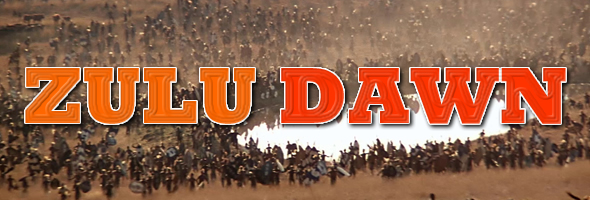
Color, 1979, 113m.
Directed by Douglas Hickox
Starring Burt Lancaster, Peter O'Toole, Simon Ward, John Mills, Denholm Elliott, Nigel Davenport, Bob Hoskins, Simon Sabela, Michael Jayston
Severin (Blu-Ray & DVD) (US R0 HD/NTSC), Tango (US R1 NTSC), Arrow (UK R2 PAL), Opening (Blu-Ray & DVD) (France RB/R2 HD/PAL), Euro (Germany R2 PAL) / WS (2.35:1) (16:9)
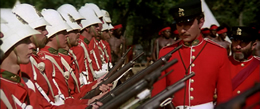 Fifteen years after the successful release of the British 1964 war film Zulu, a long-planned prequel finally opened in theaters after some notable shifting around behind the scenes. The project originally began under the auspices of director and writer Cy Endfield, who was responsible for the first Zulu and had directed De Sade and Sands of th
Fifteen years after the successful release of the British 1964 war film Zulu, a long-planned prequel finally opened in theaters after some notable shifting around behind the scenes. The project originally began under the auspices of director and writer Cy Endfield, who was responsible for the first Zulu and had directed De Sade and Sands of th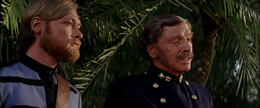 e Kalihari in the interim, while actor/producer Stanley Baker from the first film had always wanted to bring the "other" big Zulu military landmark, the Battle of Isandlwana, to cinematic life. Unfortunately neither man would live to see the project to the screen, with Baker's role ultimately played by Burt Lancaster and directing duties picked up by Douglas Hickox, helmer of Theatre of Blood, Sitting Target, and Brannigan.
e Kalihari in the interim, while actor/producer Stanley Baker from the first film had always wanted to bring the "other" big Zulu military landmark, the Battle of Isandlwana, to cinematic life. Unfortunately neither man would live to see the project to the screen, with Baker's role ultimately played by Burt Lancaster and directing duties picked up by Douglas Hickox, helmer of Theatre of Blood, Sitting Target, and Brannigan.
In 1879 South Africa, British forces are conspiring at Cape Colony to demolish the Zulu natives around them to make way for more industrial space. The scheme is led by Sir Henry Bartle Frere (Mills) and Lord Chelmsford (O'Toole), who deliberately present a ridiculous dissolution plan to one of the Zulu leaders, Cetshwayo (Sabela). The pretext works well enough to mount a planned invasion despite reservations from some of the other British soldiers, particularly Lt. Vereker (Ward), while Col. Durford (Lancaster) and his escorts are sent to scout and determine the size of the Zulu army. The end result became one of the biggest blunders in military history.
A video mainstay since its release, Zulu Dawn has never been regarded with the same esteem as its predecessor, partially because many audiences only saw it theatrically in a severely shortened version running 98 minutes to program it more easily on double bills. The prestige cast and lavish scope visuals would have made this a hit a few years earlier, but by '79 the all-star epic formula was starting to feel a bit out of date in the midst of more modern popcorn blockbusters. That said, time has been very kind to the film; O'Toole in particular gives an excellent, restrained performance (shot right after his fantastic turn in The Stunt Man), and the supporting cast teems with famili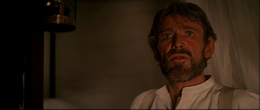 ar faces like Denholm Elliott, Phil Daniels, Nicholas Clay, and Bob Hoskins, among others. Elmer Bernstein also supplies a modest but effective music score, and while Hickox will never be mistaken for a major auteur, he keeps things moving throughout with hundreds of extras often bustling across the screen. Of course, the real reason to watch this is the action scenes, with the climactic battle making for a pretty spectacular, eye-filling experience you couldn't really appreciate back in the days of pan-and-scan VHS.
ar faces like Denholm Elliott, Phil Daniels, Nicholas Clay, and Bob Hoskins, among others. Elmer Bernstein also supplies a modest but effective music score, and while Hickox will never be mistaken for a major auteur, he keeps things moving throughout with hundreds of extras often bustling across the screen. Of course, the real reason to watch this is the action scenes, with the climactic battle making for a pretty spectacular, eye-filling experience you couldn't really appreciate back in the days of pan-and-scan VHS.
Due to a series of financial and legal dealings, Zulu Dawn has hopped distributors several times since the '80s and suffered from some truly terrible transfers, including a wretched non-anamorphic US DVD from Tango that hacked its scope compositions down to 1.85:1. The dual-format Blu-Ray/DVD release from Severin, which is region free, is a pretty big deal for fans as it presents the film in its correct 2.35:1 aspect ratio from a new HD transfer. It's worth noting that the end credits sport a credit for Dolby noise reduction, which has led some to assume the film was originally shown in two-channel stereo in some theaters; there's no actual stereo notation, though, and every existing video version has been mono, so for all we know at the moment this is the correct (and only) option. Anyway, the film can be played with either Dolby Digital or DTS-HD mono, and if you can go for the Blu-Ray option, it's far better; the DVD looks pretty compressed and flat by comparison. The Blu-Ray was obvious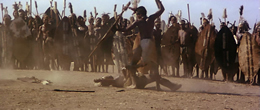 ly made from a transfer by the same folks who did the one for Severin's early Ashanti; there's definitely been some noise reduction applied in varying degrees of intensity, but the colors are very rich and impressive, and detail at least moves up several notches over the lousy previous versions. (Needless to say, it would be completely unfair to compare this film to the reference quality British Blu-Ray of the original 70mm Zulu, which is still one of the most gorgeous HD transfers ever released.) A pretty terrific film, and presumably this is the first time it's ever been uncut, properly framed, and respectably presented all in the same package. Incidentally, a French Blu-Ray made it out of the gate a couple of weeks before this one but, according to reports, is a shabby-looking upconvert from the old PAL DVD.
ly made from a transfer by the same folks who did the one for Severin's early Ashanti; there's definitely been some noise reduction applied in varying degrees of intensity, but the colors are very rich and impressive, and detail at least moves up several notches over the lousy previous versions. (Needless to say, it would be completely unfair to compare this film to the reference quality British Blu-Ray of the original 70mm Zulu, which is still one of the most gorgeous HD transfers ever released.) A pretty terrific film, and presumably this is the first time it's ever been uncut, properly framed, and respectably presented all in the same package. Incidentally, a French Blu-Ray made it out of the gate a couple of weeks before this one but, according to reports, is a shabby-looking upconvert from the old PAL DVD.
You also get some very substantial extras on the Severin release starting off with "The History of the Zulu Wars," a 25-minute overview of the real history behind the film with writer Ian Knight, author of the non-fiction study, Zulu Rising: The Epic Story of Isandlwana and Rorke's Drift. Incredibly, he manages to talk nonstop about the ins and outs of the two major battles during what appears to be a single take for almost half an hour, basically giving you a college-level crash course in the major players from the period including some later information you won't find in either of the films. The 20-minute "Recreating the War" features the film's historical advisor, Midge Carter, talking about the weapons research to put together the arsenals for the film, working with South African native police as extras (with walkie talkies inside their shields!), and other fun little tidbits about mounting the large-scale finale. "A Visit to the Battlefield" has Knight returning in front of the camera for a 16-minute tour of the real locations from the film, which was shot in the real Natal. He points out numerous existing landmarks where the real turning points of the battle occurred, and it's actually a little strange to see the landscapes looking so empty and peaceful now. The package also includes the theatrical trailer and, in a surprise not noted on the packaging, 12 minutes of outtakes (sourced from a VHS copy) from the climax of the film, featuring raw production audio and a whole lot of extra Bob Hoskins footage. The original clapboards are still left in for many shots, too, a nifty extra touch. All in all, a very satisfying release that finally makes up for years of neglect for a very impressive film.